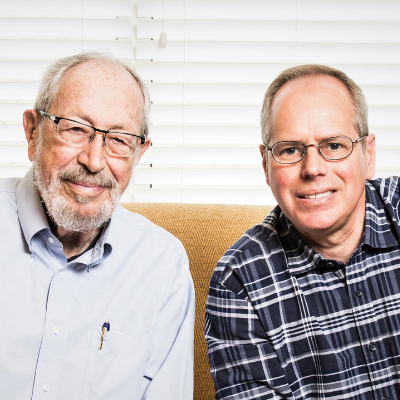When people think about becoming a boss, the first thing they think of is often that they get/have to start telling people what to do now. However, in high functioning teams, a new leader realizes the most important function is to build relationships with team members early on. In fact, Ed and Peter Schein would say that the primary job of a leader is to build trust. Role-based authority is a legacy of past systems that has to go in favor of focusing on the human side of relationships.
What we learned from this episode
The difference between role relations and personal relations when it comes to leadership and management
Command and control should be distributed among people who know each other
What is “here and now” humility
Availability is key to building trust and relationships
What you can do right now
As a human leader, your primary role is to build relationships and trust
Don’t eat your lunch alone
Key quotes
“The questions you don’t ask are maybe far more important than the ones that you do. In other words, you want your people to be sharing information at the level that they’re answering questions you don’t ask because it’s the things that you don’t know or the constructs that you’re not framing and interrogating that may be far more important.”
“That’s how you get to know people. You make yourself available. You have to be more open yourself. And gradually, people will realize that this kind of openness is good.”
”This distinction between managing the task and telling people what to do is what’s got to go. And what has to replace it is the feeling if I’m the boss now and I am know that I’m trying to build teamwork, openness, and trust, I can legislate and ask people to speak up more, to get to know each other. I can demand that they have lunch with me or breakfast and that we get to know each other.”
Links
Today, our guests are Ed and Peter Schein. They are the cofounders of the Organizational Culture and Leadership Institute. They have a great history to share with us. And this episode is Work Minus Command and Control. Hi, guys. How are you today?
We’re great.
Thanks for joining us.
So excited. I want to have you both introduce yourself a little bit. Ed, let’s start with you because you’ve come with a lot of experience to this topic of organizational culture. If people don’t know you, they should, but go ahead and give just a little bit of introduction about yourself.
I’m basically a social psychologist, got my PhD at Harvard, which mixed sociology, anthropology, and psychology, which is important in thinking about this topic. I worked there for 50+ years in the School of Management. And so, my insights into this come partly from teaching, partly from research, but mostly from consulting and seeing what actually goes on in the world of command and control and not liking a lot of what I see and having a mentor, Douglas McGregor, who talked way back then about Theory Y which is a better, a newer way of thinking about the relationship between a superior and a subordinate, and among the team members. So, my deep interest in this is in that relationship. And we’ll talk more about that.
And then Peter, tell us how you got started in your career.
So, my career started in Silicon Valley, really, in the early 90s. I did a few years in strategy consulting, and then came out to worked at Apple and then a few startups and then spent quite a few years at Sun Microsystems in corporate development. And I think that there’s a lot of things that happen in startups in Silicon Valley that is so organic and disruptive that it’s hard to put your finger on anything that seems wrong or right. It just can be so crazy that I wouldn’t say that I was saying things that necessarily I thought was managing things the wrong way in Silicon Valley. I think what Ed and I see that concerns us more is when organizations get larger and some of the bureaucratic norms end up being if not destructive, they’re certainly constricting. And so, I think that’s more what we both saw. And so, three years ago, we got together and formed the Organizational Culture and Leadership Institute so that we could do some consulting, some coaching, and some writing about some of these things that we think are going on. The other thing that I would mention is that our book, “Humble Leadership“, is very much in the zeitgeist. It’s another thread in a tapestry that’s being woven where a new spirit of humanism is really coming up from a lot of different voices. So, people who’ve read Brene Brown, or maybe have read Stanley McChrystal’s “Team of Teams“, or have read Frederic Laloux’s “Reinventing Organizations“, we’re not the only voice in this zeitgeist. There’s a lot of people who are talking about this. We saw it, we heard it, we felt it, and we wanted to get together and write more about it.
Let’s talk about this idea of command and control. When you think about, especially large organizations, that’s immediately what we think of, someone’s a manager, they’re supposed to be commanding things, controlling what’s going on. I think, in general, that this idea has fallen out of favor, but in practice, it’s still going on in a lot of ways. Why are organizations still latching on to that or managers themselves?
Well, because command and control are intrinsic concepts in any kind of work situation. There has to be some hierarchy, some system of allocating work, and there has to be some system of deciding, are we accomplishing our goals. So, we can’t get rid of command and control. What we have to get rid of is the way in which in post World War II machine bureaucracy, based on role relations rather than personal relations. If you think of command and control between roles, you get all this pathology of the boss thinking that he or she is totally accountable and therefore they have to manage everything. That is a product of defining everything in bureaucratic role terms, which I think of as the old culture of management. What is new in the McChrystals, and then the team base, and in the new forms of organization, is that there is still command, but command is distributed among people who know each other. And similarly, control is distributed among people who have gotten to know each other. So, that what’s really new is the way in which we think about who’s in charge and who should be measuring what, always based on a more personal relationship between the people in the hierarchy. Hierarchy won’t go away. But the bosses I’ve known and over my history, who are really great bosses will tell you, I really got to know my people. And once we got to know each other, this command and control stuff didn’t matter much. We just automatically sorted it out. It’s the getting to know each other, the level two relationship, getting past role related bureaucracy that is the key to our and many other people’s new ideas.
I want to follow up on this question about who’s in charge because that sometimes should be easy to define. Whoever has the biggest title seems to be in charge. But when you talk about things like accountability and control and command, what is the real factor to say who’s in charge? How do you define that?
Well, I can give you a quick case in our book. One of my colleagues out here in my retirement home was the leader of the Poseidon missile program of building a nuclear warhead that can be shot off a submarine. And he tells in great detail how 150 people, with him in charge, collectively felt accountable for making this thing work over an R&D period that lasted four or five years, many false steps, but he said the key was that every engineer, every one felt accountable. How did that happen? Because the bosses above him wanted it that way. And his own approach to the various teams and sub units was to pass that accountability down to them. And he says it worked. Nobody copped out. They all felt accountable.
One of the things we talk a lot about in the “Humble Leadership” book is how important trust is that you could make the argument that if you really establish strong mutual trust, accountability is taken for granted. You don’t need accountability to be a tool or an attribute of command and control. Accountability is trust. In the same way that if you are truly open and sharing information, that moves the ball forward, that gets people to make better decisions in your teams or your groups, you don’t need to have the thing that everybody calls transparency these days. Transparency is when you don’t trust the other side or the other members of your team or your peers. The other thing that I think came out of some of the ideas of the Machine Age of organizations coming out of the Frederick Taylor models of efficiency is that you ended up building a system where you have work lanes, and effectively, you have middle managers competing with them with each other, staying in their lanes, but competing with each other, and hiding the ball, concealing information, not sharing pertinent details that would help the other manager. It was a way of competing up the corporate ladder. But we just think that that, again, that is a very constrictive model of progress for organizations that are trying to grow at its best. And at its worst, it’s genuinely entropic and destructive to have concealing information be the way to succeed rather than sharing information.
You’ve mentioned your book a few times, “Humble Leadership“. Tell us more about that topic, why the title, and then there’s a lot of different types of leadership books out there. Why is humility something you wanted to focus on?
Well, in various writings about this, it’s very important that we describe what we mean by here and now humility rather than some vague general notion of humility being as less good or less smart or something than other people. What we are talking about as here and now humility is in the safety field called situational awareness. The leader of today is aware that the problems he or she is trying to solve are way beyond his or her individual information capacity to make the decision. The humility is I recognize that I’m dependent on my team, sometimes my boss, sometimes my subordinates, and that I need to build relationships that will get them to tell me the truth so that when we make a decision, it will be based on actual information rather than my subordinates telling me what they think I want to hear. I have to be humble in respect to them in that they know stuff that I need to know. So, humility is a relational concept in our view. It’s not a personality trait. And it’s a situational concept of the leader shouldn’t be making decisions if they have insufficient information, they should build a relationship that will elicit that information. That requires humility and making oneself vulnerable. And it’s the only way to deal with complex problems.
And just a related way to frame this, too, is that in the sort of command and control model, if you’re in a leadership position, you can ask questions and elicit answers of your people. That’s the model. That’s what the command and control means. What we’re suggesting is that the questions you don’t ask are maybe far more important than the ones that you do. In other words, you want your people to be sharing information at the level that they’re answering questions you don’t ask because it’s the things that you don’t know or the constructs that you’re not framing and interrogating that may be far more important. Does that make sense?
So, one topic we come to quite a bit as we talk about Work Minus, we talk about the use of computers, use of technology, to come into things, and we’ve even discussed how management is even being influenced by software. Do you feel like a computer is by nature a humble system? Or is it more arrogant?
Let me intervene here before we answer the computer question on the minus part. The thing that really has to go is the idea of professional and social distance between the boss and the subordinate and between team members. We haven’t mentioned that. But that’s crucial. In the old system, in the old culture of management, distance was required between the roles to make the machine work. You didn’t want nepotism. You didn’t want all kinds of relationships because that interfered with the perfect machine model. When complexity intervenes and tasks are now far more organic, the distance between people has to decrease in order to build the trust and the information. And so, the question then of where does the computer and the network and all that fit in becomes an interesting question so long as we accept the fact that the goal of the communication system has to be to reduce distance rather than to maintain it.
And I guess I would add this sort of framing of arrogance versus humility, I’m not sure that’s really how we see this. I think our view would be that there are certain kinds of work endeavors that require a level of adaptiveness, and as Ed mentioned, situational awareness that we don’t think even the best AI is really capable of because it’s interactive and it’s social. So, in certain contexts where what we’re trying to do is process information really quickly and make some decisions or transactions or handoffs, I don’t see any reason why we shouldn’t expect that AI is going to perform that more efficiently than human beings. I think there’s plenty of data to suggest that. Where we don’t really see AI taking over is in that spontaneous effectiveness, which is where creativity and innovation come from. So, does the computer know to peek into somebody’s office or tap somebody on the shoulder and have a spontaneous conversation where you get information and then a new idea forms. That’s where we’re just not sure that we need to worry too much about AI. AI is going to be very good at replacing transactional role based work. But that’s not where we’re all going in the future. We’re all creating and innovating. And so, we need to harness the power of big data to feed us information. But that contextual processing is something that I think humans are better at and will be for a while.
And that’s why reducing that professional distance maybe is even more important now as humans lean in more towards those very interhuman roles, recreating that spontaneous effectiveness to be able to know that person. Would you agree with that that’s why professional distance is so important?
Yeah. That is exactly how we see it.
Well, I was going to say the dilemma of the internet is how we reduce that distance when we are not always colocated. So, one of the most interesting questions for future research will be, I think, people will need to be close to each other and know each other. But how they will accomplish that on the internet will be something that is right now evolving by seeing how the new generations of kids are doing this. How do they know, if they haven’t got daily face to face contact, whether they can trust each other on their internet messages? To me, those are crucial questions for the future because trust and knowledge are going to be crucial. But how do you maintain them when you don’t see each other every day will be a big question.
We talk a lot about how these things are complimentary, the idea of a meal or a drink after work or a lunchtime walk around the neighborhood. Those things are very powerful in developing just that intrinsic human trust, or as we described in the book, a level two relationship. Those are never going to be replaced by even the best variants of telepresence or however you want to describe what we’re capable of doing with video and groupware over high speed networks. So, it’s critical to keep those two things in balance, the mix of local contemporaneous versus distant but highly efficient. One thing, though, that I just want to add that’s a new angle on this is the we works and the different shared workspaces is becoming a very important part of our physical environment in work these days. And one of the things that’s very interesting about those is that it becomes a social context where it’s not intracompany. It’s intercompany. The relationships developing in the spontaneous ecosystems between companies may be as important as the relationships that are forming within teams and within work groups. It’s a very promising and fascinating and interesting thing to see develop.
That’s very interesting. Let’s close out with a question about what if somebody comes into a situation where they’ve inherited an environment of low trusts, of high distance. They’re trying to come in. There’s a lot of these role based challenges, a lot of friction that’s going on. What are some ways that somebody can increase trust and decrease the friction in those situations?
The leader or the manager in that situation has to, first of all, have the insight that I’ve got to build relationships with these people who are not used to this. And the way I’ve seen it done, and we described a couple of cases like this in our book, is a guy who took over a large international, multiproduct corporation as the executive VP at four different companies in four different industries. He decided that he had to get to know the executive team of each of those companies. So, he allocated a week or so in each case to getting to know the individual people, mostly by making himself more vulnerable, going to these teams and saying, look, I don’t know your business the way you do. And yet, I need to get that knowledge. So, educate me and we’ll spend time together. Another example of how Mr. Packard, when he opened a plant in Singapore with an Australian manager. I said how did you learn about the culture of HP? And he said, well, when I first took the job, the first thing they asked me to do is to come to Menlo Park. And I spent two entire weeks shadowing Mr. Packard. So, if you look at this from Packard’s point of view, that’s how you get to know people. You make yourself available. You have to be more open yourself. And gradually, people will realize that this kind of openness is good. Even though in under past managers, it has been discouraged, our new manager seems to want more of this so we’ll gradually open up.
Another thing that we talk about in the book is the idea of using the check in process as a way of trying to break down some of those role barriers. So, if you’re going into a meeting, you’ve got a full agenda, and you know it’s going to be hard to get through the agenda, it’s hard to factor in something that’s a very social process that has nothing to do with the agenda, but you may end up with a far more effective meeting if you start out by saying we’re going to do a check in where everybody we’re going to go around the room and you can’t pass. You have to say what’s on your mind. And select some of the air out. Let some of this stuff out into the open. If people are feeling resistant or if people are feeling suspicious, or skeptical, or dubious, get it out into the open. It’s not going to do any good when you all know it’s there, it’s the elephant in the room, but if it isn’t spoken, if it isn’t aired out, you’re stuck. So, it sounds like a simple, easy, maybe easier said than done, but put the agenda aside for a few minutes and try to get every voice in the room heard and see how that improves the dynamic.
What we need to get rid of is managers attitude that I used to encounter regularly in my class. I would ask when you were first promoted to manager, what did that mean to you? And invariably, 100% of the people said, “It means I can now tell other people what to do.” What you cannot do, because you don’t know enough, is to tell people what to do in terms of the tasks of the group. So, this distinction between managing the task and telling people what to do is what’s got to go. And what has to replace it is the feeling if I’m the boss now and I am know that I’m trying to build teamwork, openness, and trust, I can legislate and ask people to speak up more, to get to know each other. I can demand that they have lunch with me or breakfast and that we get to know each other. So, it’s a subtle but crucial difference, whether the manager manages the content or the process.
That’s a very important distinction. I like that. And as we’re talking about Work Minus Command and Control, like we said, there’s always going to be some element of hierarchy. And there’s always some element of authority. So, how do you use that? Do you apply that to the task or to the process? I like that a lot. Ed and Peter, you guys have been great to have on. You’ve been sharing a lot of stuff with us. Obviously, you could go on for a long time. Where can people go to learn more about your writings, about your thinking, and your books?
So, a couple places. One is ocli.org. And that’s our Organizational Culture and Leadership Institute. Another place is humbleleadership.com. That’s specific to the “Humble Leadership” book. And then Amazon because most of Ed’s books are on Amazon, or other online sellers, but we know for a fact that they’re available on Amazon and easy to get through that channel.
And if you’re into culture, definitely you need to start with Ed’s books. It really gives you the perspective of where we’ve come to in the discussion about culture. So, I definitely recommend that.
And Neil, since you mentioned that, you’ve invited me to plug something. In July, we’re publishing an update to the “Corporate Culture Survival Guide,” which was a pretty well-received book in the business community that gave people that first sense of, geez, what is this culture stuff all about? We’ve updated it quite a bit, added a bunch of new stories and some new frameworks. So, in July, that book should be available on Amazon.
Well, thanks a lot for being on the show and sharing all your insights with us.
Thank you.
Ed Schein is Professor Emeritus of the Massachusetts Institute of Technology (MIT) Sloan School of Management. He was educated at the University of Chicago, Stanford University, and Harvard University, where he received his Ph.D. in Social Psychology. He worked at the Walter Reed Institute of Research for four years and then joined MIT, where he taught until 2005. He has published extensively– Organizational Psychology, 3d Ed. (1980), Process Consultation Revisited (1999), career dynamics (Career Anchors, 4th ed. With John Van Maanen, 2013), Organizational Culture and Leadership, 4th Ed. (2010), The Corporate Culture Survival Guide, 2d Ed., (2009), a cultural analysis of Singapore’s economic miracle (Strategic Pragmatism, 1996), and Digital Equipment Corp.’s rise and fall (DEC is Dead; Long Live DEC, 2003).
In 2009 he published Helping, a book on the general theory and practice of giving and receiving help followed in 2013 by Humble Inquiry which explores why helping is so difficult in western culture, and which won the 2013 business book of the year award from the Dept. of Leadership of the University of San Diego. He has just released Humble Consulting which revises the whole model of how to consult and coach and is currently working with his son Peter on Humble Leadership (2018) which challenges our current theories of leadership and management.
Peter Schein is a strategy consultant in Silicon Valley. He provides help to start-ups and expansion-phase technology companies.
Peter’s expertise draws on over twenty years of industry experience in marketing and corporate development at technology pioneers. In his early career he developed new products and services at Pacific Bell and Apple Computer, Inc. (including eWorld and Newton). He led product marketing efforts at Silicon Graphics Inc., Concentric Network Corporation (XO Communications), and Packeteer (BlueCoat). He developed a deep experience base and passion for internet infrastructure as the Web era dawned in the mid-1990s.
Thereafter, Peter spent eleven years in corporate development and product strategy at Sun Microsystems. At Sun, Peter led numerous minority equity investments in mission-critical technology ecosystems. He drove acquisitions of technology innovators that developed into multi-million dollar product lines at Sun. Through these experiences developing new strategies organically and merging smaller entities into a large company, Peter developed a keen focus on the underlying organizational culture challenges that growth engenders in innovation-driven enterprises.
Peter was educated at Stanford University (BA Social Anthropology, Honors and Distinction) and Northwestern University (Kellogg MBA, Marketing and Information Management, Top Student in Information Management), and the USC Marshall School of Business Center For Effective Organizations (HCEO Certificate, 2017).












